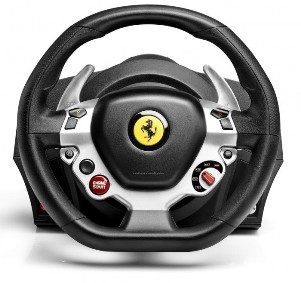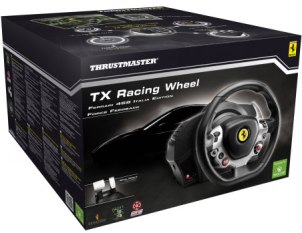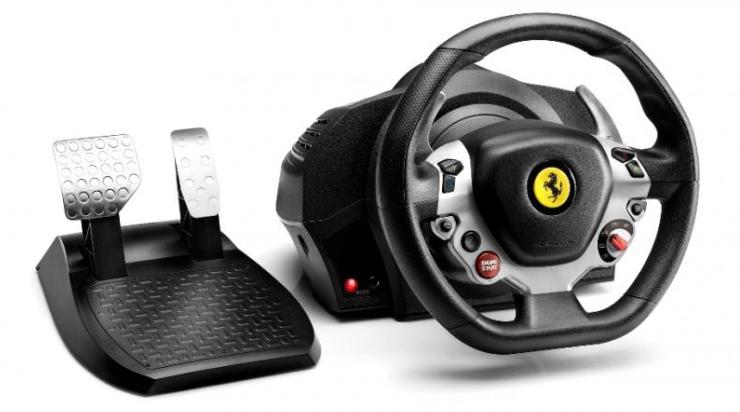You would expect a proper racing wheel to be in the arsenal of any racing game fan, though in reality, this isn’t the case. Rather, racing wheels continue to exist on the periphery of mainstream popularity. We can’t get enough racing games, it seems, but wheels to go with them? For the most part, it’s only the racing-obsessed (or financially free) gamer that keeps this business going. So, when the latest wheel offering from Thrustmaster showed up on my doorstep, ready for me to review it, I will admit to having no idea what to expect, having not picked up a racing wheel for ages. The first trial was getting the thing set up…
The TX represents the upper tier of wheel controllers offered by Thrustmaster, with the one I tested being the Ferrari 458 Italia Edition, dressed to look like the wheel found in its roadworthy namesake. Opening the box, you will find that the wheel comes in three parts, with optional extra lumps of plastic if you want to mount the wheel to a desk or table (recommended). The wheel itself is one piece to be screwed onto the base unit that houses the motors, before being wired up to the pedal unit that goes on the floor.
Setting up end-to-end took about 20 or so minutes, as I wrestled with the fiddly proprietary connections and gazed puzzlingly at the anaemic instruction booklet. I’ve got the wheel bolted to a cheap IKEA coffee table that sits just in front of the sofa, and the included clamp is a doddle to set up, thankfully. The wheel requires power from a wall socket and a wired connection to the Xbox One; along with the wire going from the wheel to the pedals, that’s a lot of cable.
 I tested the TX with an Xbox One and Forza Horizon 2, this year’s best racing game (fact). The wheel burst into life as Forza booted up, the wheel spinning this way and that as it calibrated itself. The game finished loading and I was looking at the Mustang I finished my last play session in, I wrapped my hands around the wheel’s faux leather exterior and drove, not knowing what to expect. Being the racing wheel ignorant sort of guy that I am, I was blown away, at first, with how it performed. It fights you in the corners, feeding every bump, drift and breaking effort back into your hands. Forza Horizon 2 being the game that it is really shows off what this unit can do, with off-road sections sending the wheel into overdrive, juddering excitedly with every on-screen jump and tumble.
I tested the TX with an Xbox One and Forza Horizon 2, this year’s best racing game (fact). The wheel burst into life as Forza booted up, the wheel spinning this way and that as it calibrated itself. The game finished loading and I was looking at the Mustang I finished my last play session in, I wrapped my hands around the wheel’s faux leather exterior and drove, not knowing what to expect. Being the racing wheel ignorant sort of guy that I am, I was blown away, at first, with how it performed. It fights you in the corners, feeding every bump, drift and breaking effort back into your hands. Forza Horizon 2 being the game that it is really shows off what this unit can do, with off-road sections sending the wheel into overdrive, juddering excitedly with every on-screen jump and tumble.
The feedback, then, is nothing short of amazing. I love it. I want to talk about it forever, but I can’t. You see, there is something troubling about this whole experience – the wheel sucked almost all of the fun out of Forza Horizon 2 for me, and turned it into a bit of a chore. I have spent literally hours trying to find the right settings for the wheel to act more like a pad and less like an inaccurate, boat-like control system. I had it, I really did, for about 30 minutes; I found the magic formula of random button presses and in-game menu tinkering that made the wheel a joy to use, but then a friend jumped on and ruined it all. Damn him.
As alluded to before, the documentation included with the TX wheel is so woolly and undercooked it may as well not be there. Searching through forums I found similar stories of Jaguar XK’s turning into aircraft carriers and Mustangs into boats – that is literally how the wheel makes the game feel. The cars all become totally uncontrollable, spinning out of control at 30mph when usually the car would race round at 60 or 70 is just unacceptable, realism be damned!
So, we are left with a conundrum. Did I just have the wheel set up wrong? Does the game itself have bad wheel optimisation? Or do I just suck at driving games? In reality, it’s probably a mixture of all three. In that thirty-minute spell, where the planets aligned and the wheel in my hand actually communicated with the wheels on my virtual car, all was well. If I can just find that balance again…

As a piece of equipment, the TX is a sturdy enough unit. The wheel has plush grips, satisfying flappy-paddle gear leavers and an array of (unfathomable) buttons that apparently adjust the settings. A lot of these (such as the traction control switch and suspension settings) were not supported by Forza Horizon 2, so I couldn’t get to grips with the full experience it offers. The pedal unit feels surprisingly light and cheap, compared to its more industrial sibling, so much so that its rubber grippy feet couldn’t really hang on to my laminate flooring for any extended period of time. You can adjust your play-style to keep them in place of course, but in particularly hairy on screen moments, kicking the pedals halfway across the room is almost an inevitability.
So, how to wrap up my first foray into the minefield of racing wheels in many a year. It’s fair to say that it’s been a mixed bag of emotions. Gaming euphoria to gaming frustration, all in a single corner. I have no doubt that if set up right, the TX 458 will prove the perfect companion to any racer. It ain’t cheap, coming in at nearly £300 at most retailers, so represents quite an investment. It seems for me the racing wheel will continue to exist on the edge of gaming’s mainstream, but for those willing to invest and get to grips with its settings, the TX is certainly worth a look.





